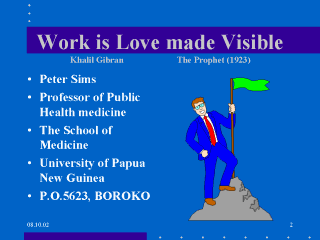| front |1 |2 |3 |4 |5 |6 |7 |8 |9 |10 |11 |12 |13 |14 |15 |16 |17 |18 |review |
 |
Clinical medicineis about understanding at the individual
level-history, examination, investigation,
diagnosis, treatment, long term follow up and care.
A patient presenting with Angina needs multiple different
interventions-he may requires
angioplasty, help in altering eating and smoking patterns, attention to
life style stresses, weight control and exercise and long term aspirin
therapy.
Public Health medicine is about the understanding of
communities-their anthropology,
sociology, examining their demography and vital statistics,
investigating problems and trying to draw effective conclusions around
which policy can be made.
E.g. Food rationing in Britain in World War 2.
There was a food shortage,it was imperative to share
the food as fairly as
possible across the population,
to
ensure at least adequate calories, protein and vitamins, to provide
extra nutrition for pregnant and lactating women and for young children.
The nutritionists did their calculations, the demographers their
calculations, the government enforced and the people grumbled but
accepted the fairness of it and were united
in a patriotic struggle.
Public Health will often be about influencing policy decisions
and often it will fall to
Public Health to implement policy and manage change. Change is about
People Change-classically increasing knowledge,.challenging attitude
constructively and delivering behavioural change.
|